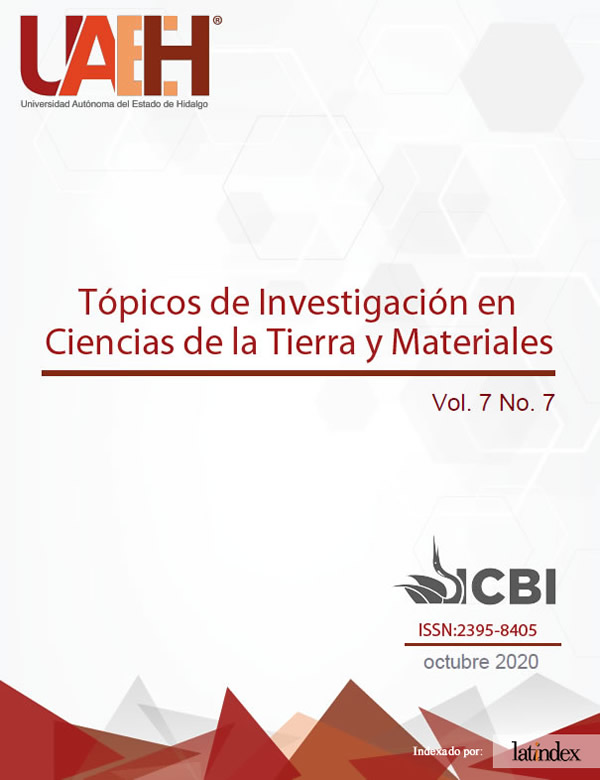Geothermal potential areas identification using GIS and potential methods in the central part of the state of Hidalgo, Mexico
Abstract
Geothermal resources are known for their most common thermal manifestations: hot springs. Currently, in the state of Hidalgo, geothermal energy is limited to the direct use of balneology, however, it is not the only application from which some socio-economic benefit can be obtained. Generating electricity from the Earth's internal heat is the process of greatest benefit from geothermal energy since the end of the 20th century. In Mexico, the first geothermal plant was installed in the Pathé community, in the state of Hidalgo; Since then and until today, the field of exploration towards geothermal energy has been extended, establishing up to now 5 geothermal plants throughout the country with a net capacity of 950 MW.
There are few investigations directed to geothermal exploration in Hidalgo, for this reason, a methodology is proposed to locate the geothermal potential found in the region by means of a qualitative analysis with those variables that favor the accumulation of geothermal energy, these variables are: geomorphology, geology, chrono-stratigraphy, heat flow and geophysics, using Geographical Information Systems (GIS) and potential methods.
The study area is the state of Hidalgo, but those areas of lesser relevance were discriminated allowing the delimitation of a particular area, this area was called geothermal play, which is located in the central portion of the state. The area covers approximately 7200 km2 with a length close to 170 km and is distributed with a preferential northwest-southeast direction (NW-SE). In order to determine the potentially geothermal areas, the Weighted Sum method was used through map algebra to obtain a geothermal potential index, this method allows the assignment of weights according to the degree of relevance for the accumulation of geothermal energy from of a previous reclassification of the analyzed variables. With the results of this research, a map was designed that shows the areas with the lowest and highest geothermal potential, and thus, provide information to the geothermal industry, generating information that will be useful for prospecting this resource and its future application in the energy sector.
Downloads
References
Aguilar-Dumas, A. (2008). Análisis geológico-productivo enfocado a la exploración de la parte oriental del campo geotérmico de Cerro Prieto, BC. Geotermia,21(1),2-25.
Arellano, V.M.,Torres, M.A.,Barragán, R.M.& López, F.N.(2005). Evolución termodinámica (1982-2002) de los fluidos del campo geotérmico de Los Azufres, Mich. (México). Ingeniería Hidráulica en México, 2(1),77-87.
Bertani, R. (2015). Geothermal Power Generation in the World 2010-2014 Update Report, En Proceedings World Geothermal Congress, The Melbourne Declaration: Australia.GRC Bulletin. 14-15. Recuperado de: https://geothermal.org/PDFs/Articles/15MayJune.pdf
Centro Mexicano de Innovación en Energía Térmica [CeMIEGeo].(2014-2019).¿Qué es la Geotermia? Recuperado de: http://www.cemiegeo.org/index.php/que-es-la-geotermia
Chernykh, V.V.(2015). Paradoxes of stratigraphy. Russian Geology and Geophysics.56(4).532-540 p. doi: 10.1016/j.rgg.2015.03.005.
Daniilidis, A., M. Nick, H. & Bruhn, D.F. (2020). Interdependencies between physical, design and operational parameters for direct use geothermal heat in faulted hydrothermal reservoirs. Geotermics. 86(20). doi: 10.1016/j.geothermics.2020.101806.
Environmental Systems Research Institute. (2016). Conceptos del conjunto de herramientas de Superposición. Recuperado de https://desktop.arcgis.com/es/arcmap/10.3/tools/spatial-analyst-toolbox/how-weighted-sum-works.htm
Fanton, G., Martinez, M.,Gimenez, M.(2015). Processing And Qualitative Data Analysis With Views Aeromagnetic Exploration Type Hydrothermal Deposits Lode Gold - La Rioja Province, Argentina. Geoacta. 39 (1). 30-50.
González-Partida, E.,Tello-Hinojosa, E.& Pal-Verma, M. (2001). Interacción agua geotérmica-manantiales en el campo geotérmico de Los Humeros, Puebla, México.Ingeniería Hidráulica en México, 7(2),185-194.
Gracia-Hernández, M. (2016). El turismo de salud en el estado de Hidalgo, México. Propuestas para consolidarlo. El periplo sustentable, (30), 157-179.
Gutiérrez-Negrín, L.C.A. (2019). Current status of geothermal-electric production in Mexico: IOP Conference Series. Earth and Environmental Science, 249, 1-11.
Hiriart, G. (2017). Private Geothermal Opportunities in Mexico.GRC Transactions, 41(1), 1-8.
Marcano, A., Cartaya, S., Pacheco, H.& Méndez, W. (2012). Estimación de pesos ponderados de variables para la generación de mapas de susceptibilidad a través de la Evaluación Espacial Multicriterio (EEM). I Congreso Venezolano de Ciencia, Tecnología e Innovación en el Marco de la LOCTI y del PEII. Ministerio del Poder Popular para Ciencia, Tecnología e Industrias Intermedias, Caracas, Venezuela.
Mochales-López, T. (2006). Prospección magnética aplicada a la detección y caracterización de dolinas en el entorno de Zaragoza.(Maestría, publicada). Universidad de Zaragoza .España.
Moeck, I. S. (2014). Catalog of geothermal play types based on geologic controls. Renewable and Sustainable Energy Reviews, 37, 867-882. doi: 10.1016/j.rser.2014.05.032.
Prol Ledesma, R.M., Cruz, J.L., Torres-Vera, M.A., Espinoza-Ojeda, O., Carrillo, Juan., & Membrillo-Abad, A. (2018). Heat flow map and geothermal resources in Mexico. Internagional e-jourrnals of maps, 2(2), 1-15, doi:10.22201/igg.25940694.2018.2.51.105.
Prol-Ledesma, R.M., Morán-Zenteno, J. D. (2019). Heat flow and geothermal provinces in México. Geothermics, 78(1), 183-200.
Ramón-Melo, ML. (2017). Análisis Geomorfológico del Cerro San Cristóbal y Cerro Cumbre Las Tres Marías: Pachuca de Soto, Hidalgo, México. (Tesis de Licenciatura, publicada). Universidad Autónoma del Estado de Hidalgo. México.
Richarte, J.M., Peláez, J.A., Sánchez-Gómez, M., & Gil, A.J. (2007). Prospección gravimétrica en la terminación norte del frente montañoso de las Béticas: Jaén, España. Revista Electrónica Universidad de Jaén, 2, 1-9.
Rondero-Guerrero, C. (2010). Cálculo promedial. El caso de la media aritmética. Relime. 13 (4-2): 387-408.
Sas, J., Osvald, M., Ramalho, E., & Matos, J. (2018). Combined study of mineral deposits and deep geothermal for energy production or urban heating – Comparison between the Portuguese (Neves-Corvo) and the Hungarian (Recsk) case studies. Central European Geology. 61(2). 118-135 .
Tarbuck, E.J., Lutgens, F.K.& Tasa, D. (2005): Ciencias de la Tierra: Una introducción a la Geología física. Pearson Prentice Hall. 8ª ed. 710 pp.
Zhdanov, M.S. (2015). Inverse Theory and Applications in Geophysics, en Zhdanov, M.S (2nd ed), Forward and Inverse Problems in Science and Engineering: Department of Geology and Geophysics, University of Utah, Salt Lake City, UT, 84112, U.S.A. Elsavier. 3-31.
Zobin, V. M. (2017).The Seismic Signals Associated With the Natural Seismicity of Geothermal Structures Within Volcanic Environment. Introduction to Volcanic Seismology .(3 Ed), 497-517.












